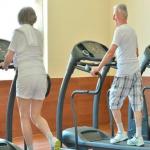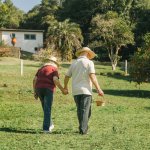How Older Adults Can Get Started With Exercise and Why It's Important
As we age, maintaining an active lifestyle becomes increasingly crucial for our overall health and well-being. Ignoring exercise in later years can lead to significant health issues, including back problems and other physical ailments. Fortunately, even a small amount of daily exercise can help prevent these issues, allowing older adults to continue enjoying an active lifestyle. This article explores how older adults can begin exercising and why it's essential.
Why Exercise is Important for Older Adults
For older adults, regular exercise offers numerous benefits that can significantly enhance their quality of life. Here are five key reasons why exercise is vital:
1. Disease Prevention
Regular physical activity can help prevent a variety of common diseases, such as:
- Heart Disease
- Diabetes
- Degenerative Disc Disease
- Certain Cancers
Exercise strengthens the immune system, which is particularly important for older adults as their immune function can decline with age. Even gentle activities like a brisk morning walk can contribute to disease prevention.
2. Enhanced Cognitive Function
Exercise improves motor skills, which in turn boosts cognitive function. This enhancement can reduce the risk of dementia and other cognitive impairments. Starting an exercise routine at any age can yield significant cognitive benefits.
3. Improved Mental Health
Physical activity triggers the release of endorphins, hormones that promote a sense of well-being. These hormones help reduce stress, improve mood, and decrease the likelihood of developing mental health disorders. Additionally, regular exercise can improve sleep quality, which is often disrupted by stress and poor mental health.
4. Increased Strength and Flexibility
Exercise enhances strength and flexibility, improving balance and coordination. This reduces the risk of falls and injuries, which can have severe consequences for older adults. Preventing falls is crucial, as recovery can be prolonged and challenging.
5. Social Engagement
Exercise can be a social activity, whether through joining a walking group, attending fitness classes, or participating in team sports. Social interaction is a key motivator for maintaining an exercise routine and can help combat feelings of loneliness or depression.
How to Get Started with Exercise
Starting an exercise routine can be daunting, especially for those who are out of shape or overweight. However, with the right approach, exercise can become an enjoyable part of daily life. Here’s how older adults can get started:
Determine Your Fitness Level
Before beginning an exercise routine, it's important to assess your current fitness level. This can be done by:
- Checking your pulse rate after walking a mile
- Timing how long it takes to walk a mile
- Counting how many push-ups you can do
- Measuring how far you can reach forward while sitting
- Measuring your waist circumference
Create a Fitness Plan
A well-structured fitness plan can make exercising more manageable. Consider the following:
- Set Clear Goals: Determine whether your goal is weight loss, increased strength, or improved flexibility.
- Develop a Balanced Routine: Start with manageable activities and gradually increase intensity.
- Incorporate Variety: Engage in different activities to work various muscle groups and keep things interesting.
- Make it Enjoyable: Listen to music or audiobooks while exercising to enhance the experience.
- Include Rest Days: Allow your body time to recover and prevent burnout.
Monitor Your Progress
Regularly assess your progress to ensure your fitness plan remains effective:
- Re-evaluate your fitness level every six weeks initially, then every three months.
- Adjust your routine based on results and personal preferences.
- Experiment with new exercises to keep your routine engaging.
The Consequences of a Lack of Exercise: Severe Back Conditions
Neglecting exercise can lead to spine-related issues, such as:
- Herniated Discs
- Spinal Stenosis
- Degenerative Disc Disease
These conditions can cause severe pain and limit mobility, significantly impacting quality of life. In some cases, surgical interventions like laminectomy or spinal fusion may be necessary. Regular exercise is crucial for maintaining spine health and overall well-being.
Spondylolisthesis and Spinal Stenosis in Older Adults
Two additional conditions that can arise from inactivity are spondylolisthesis and spinal stenosis. Spondylolisthesis occurs when a vertebra slips out of place, often due to degenerative changes in the spine. This can lead to nerve compression, causing pain, numbness, or weakness in the legs. Spinal stenosis, on the other hand, involves the narrowing of the spinal canal, which can also compress nerves and result in similar symptoms. Both conditions are more prevalent in older adults and can severely limit mobility if not addressed.
Regular exercise can play a preventive role by strengthening the muscles that support the spine, improving flexibility, and enhancing overall spinal stability. Activities such as swimming, yoga, and tai chi are particularly beneficial as they are low-impact and promote core strength and balance. Early diagnosis and intervention are crucial for managing these conditions effectively, highlighting the importance of regular check-ups and staying active.
Additional Tips for Success
According to health experts who write for us on elder care, to further support your exercise journey, consider these additional tips:
- Consult a Professional: Speak with a healthcare provider or fitness expert to tailor a plan to your needs.
- Stay Hydrated: Drink plenty of water before, during, and after exercise.
- Wear Appropriate Gear: Invest in comfortable clothing and supportive footwear.
- Stay Consistent: Make exercise a regular part of your routine to maximize benefits.
Thank you for reading. We hope this guide helps you embark on a rewarding exercise journey that enhances your health and happiness.
More to Read:
Previous Posts:




